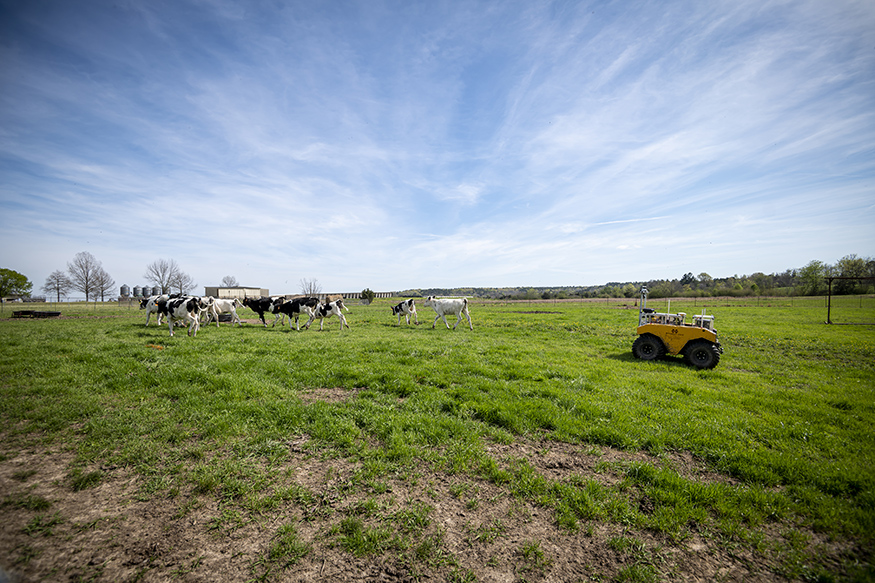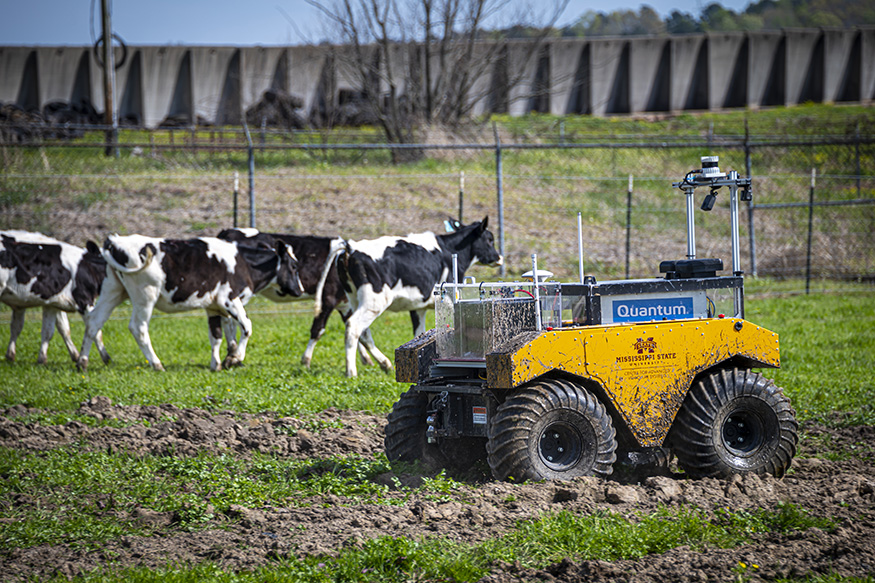Robot Roundup: Autonomous cattle herding studied by MSU scientists may be game changer

Contact: Meg Henderson
STARKVILLE, Miss.—It takes a team effort at Mississippi State’s Bearden Dairy Research Center to produce 369,000 gallons of milk every year from 200 cows. A surprising new team member showing potential for herding large numbers of cows is a ground robot, equipped to navigate pasture and sense and direct herd movement.
Investigating the possible use of uncrewed ground vehicles for safer and more efficient livestock movement and management are scientists in the university’s Mississippi Agricultural and Forestry Experiment Station, Center for Advanced Vehicular Systems and Raspet Flight Research Lab.
Principal investigator Marcus McGee, assistant clinical professor in the Department of Animal and Dairy Sciences, and co-PI Christopher Hudson, a CAVS research engineer, have conducted a series of trials at the MAFES Dairy Research Center with a Clearpath Robotics Warthog UGV fitted with cameras and sensors.
Manually operating the UGV to move the cattle, the research team demonstrated its effectiveness and now plans to apply for a U.S. Department of Agriculture grant this fall, studying how groups of UGVs move cattle and exploring building requirements for an autonomous cattle-driving system. Currently, the MSU experts are studying how herding principles might apply to robots, with a goal of creating a set of rules for autonomous herding vehicles.
“If you’re designing a self-driving car, it follows the rules of the road which have been established over many decades,” Hudson said. “We don’t have rules for how one vehicle, let alone a team, should work to detect, see and move cows.”
The animals’ behavior around the Warthog during the trials has shown signs of acceptance and willingness to be moved by an uncrewed vehicle.
“To our surprise, the animals were calm around the Warthog and behaved the same way they would around a person on horseback or driving a four-wheeler,” McGee said. “Young calves don’t have the strong herd instinct that mature animals do, but we saw that in the presence of the robot, these calves moved along like a herd—not scurrying in fear but loping along together.”
In addition to herding, a UGV could monitor the health of individual animals more frequently and with more precision than humans can, thus expediting medical treatment.
“An autonomous system equipped with cameras and thermal sensors could potentially detect illness or injury, and that data could help us identify which one needs to be separated from the herd and when we should notify the farmer or veterinarian,” McGee said.

The scientists see autonomous UGVs as a game changer for the animals and the livestock industry, much like precision agriculture technology is changing how crops are grown and monitored. As with agriculture, livestock management relies on repetitive tasks performed at the same time each day, and these tasks lend themselves well to automation.
“Herding cattle can be a physically demanding and dangerous job, and it’s getting more difficult each year to find people to do it,” Hudson said. “We see this as an area where robots can make a positive impact as a workforce multiplier by doing the repetitive manual jobs. As the technology is expanded, the potential to create higher-paying technical jobs will evolve.”
“In the next decade or so, we may see livestock producers working alongside engineers and computer scientists,” McGee added. “Jobs in the industry’s future will likely be very different from the ones we have today with increased adoption of precision livestock management.”
While the end goal of autonomous herding lies on the horizon, these scientists see their work as building the foundation—the rules of the road—for the successful deployment of existing robotics technology in a livestock setting.
“At Mississippi State, we work together across disciplines to solve pressing issues, including the ability to augment skilled labor in the workforce,” Hudson said. “Because of our excellence in agriculture, engineering and uncrewed systems, MSU is uniquely qualified to be a leader in this emerging field of research.”
For more on the Department of Animal and Dairy Sciences in MSU’s College of Agriculture and Life Sciences, visit www.ads.msstate.edu. Learn more about MSU’s Center for Advanced Vehicular Systems at www.cavs.msstate.edu. The Raspet Flight Research Lab is found online at www.raspet.msstate.edu.
Mississippi State University is taking care of what matters. Learn more at www.msstate.edu.